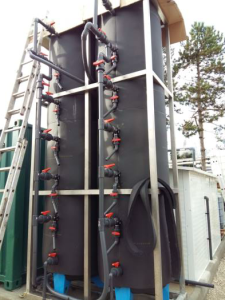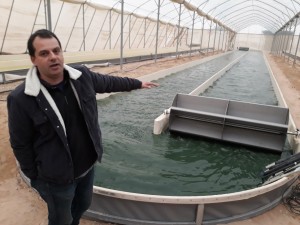The Saltgae project has been developing its activities since the end of 2016 in order to provide a simpler and economically sustainable solution to the important problem of the treatment of high saline waste waters with organic load, such as the effluents of the food & beverage industry. Saltgae implies the use of a combination of different technologies for the elimination of pollutants and their recovery. It has overcome scientific and technological barriers to move from the laboratory, through piloting, to reach demonstration level located in three sites. The project has needed the collaboration of 21 organizations with experts from different areas, genomic, desalination, anaerobic-digestion, water treatment, chemical transformation and sustainable studies, from both academy and industry to develop key innovations in a complementary and effective way.
Challenge that the research addresses
For any industry generating vast amounts of wastewater, management of their residues required to comply with the EU directives involves direct costs which can be very high. This is particularly critical for a subsector within the F&B industry devoted to the production of canned fish, meat processing, pickled vegetables, leather tanneries, aquaculture and all kind of brined products, as they generate high saline wastewater. Conventional wastewater treatments have proven ineffective for this case, as the bacterial processes typically used for the elimination of organic matter and nutrients are inhibited under the high salinity conditions. This kind of wastewater, with the high concentrations of biodegradable organic matter, suspended solids, nutrients (nitrogen and phosphorus) and salt (up to 15%), is extremely difficult and expensive to treat, and its discharge represents a major threat to the environment. Saltgae is addressing this market with development of an innovative and cos-effective solution for saline wastewater treatment using a combination of algal treatment, specially modified anaerobic digestion and desalination technologies to recycle energy, nutrients and produce valuable algae-based products.
Key results of the project
a) Salt-tolerant anaerobic bacterial
The efficient removal of important soluble organic matter in these highly saline wastewaters has been achieved thanks to the development a salt-tolerant anaerobic digestion. Converting organic matter to energy is best achieved by the methanogenic archea, but they cannot survive in elevated salinity levels.

To overcome this problem, a smart strategy was employed implicating three critical measures: firstly, to separate other anaerobic digestion processes that are much less salinity sensitive from the methanogenesis. The second measure is providing methanogenes with granular substrates where they can hide from high salinity levels. The third is selection of species and variants that will perform well. Results from laboratory testing of anaerobic digestion has enabled us to design pilot scale equipment used at the demo sites.
b) Innovative use of aerobic algal-bacterial treatment
Wastewater is also frequently treated by bacteria using aerobic processes. Organic substances that come with the wastewater are consumed by bacteria, which uses a lot of oxygen that need to be externally supplied (usually by aeration). Optimally, the process is designed in such a way that bacteria convert these organic substances into CO2 that is released to the atmosphere; some of the organics are inevitably built into the biomass which is removed (wastewater sludge).
When we add algae to such system, they can consume the CO2 produced by bacteria and convert it into their own biomass using solar light (photosynthesis). A side product of this process is oxygen, which replaces the need for aeration. Algal-bacterial process thus not only eliminates the energy requirement of aeration but captures nitrogen and phosphorous from water and also partially embodies the carbon contained in the wastewater into biomass which can then be valorised. As result, the treatment is much cheaper due to the reduced costs of aeration, CO2 is recycled rather than contributing to the climate change, and biomass can be further utilized (and sold). Natural algal-bacterial communities are adapted to increasing salinity load in these wastewaters, experimenting changes in ratio of species which were tracked through a detailed genetic microbial community analysis.
c) Valorisation of biomass
Algal-bacterial treatment produces significant amount of biomass and its exploitation is an important aspect when proposing Saltgae as a sustainable solution. Harvesting has been enhanced by using membrane techniques which allows algae concentration >250g/l. Dry algal biomass has been investigated as feed ingredient for piglets.

This biomass has been also fractionated for its maximum use: polar lipid fraction with omega-3 for food supplement, non-polar lipid fraction with low fatty acid for production of resins and adhesives and protein fraction for edible coatings for fruits. Finally, algal biomass is used as high value fillers or constituents in biocomposites used in 3D printing to produce complex structures in clay, cement or other similar materials.
d) Integration and testing in demo sites for wastewater treatment of F&B industry
Being Saltgae a modular treatment platform, smart integration of the different technologies is of crucial importance at time of increasing performance and saving resources. The innovation developed have been scaled-up and integrated in three demo sites available at different locations (Israel, Italy and Slovenia). They present different climatic conditions and origins for the wastewater to be treated, which allows confirming its versatility thanks to Saltgae modular design: water from the milk industry (Spirulina or Tetraselmis, 20 kg/day), water from hide warehouse as representative of tannery wastewater (mixed algae, 6 kg/day), and water from the fish farming to grow Spirulina (alga used for food, 5 kg/day). Processes in each of these demo sites are as diverse as they will be in the real industrial sites and modules are adapted to the quality of the substrate.
A visualization toolkit has been created to illustrate the economic and environmental potential of the SaltGae solution in a wide range of scenarios. The toolkit facilitates site-specific user interaction that allow potential stakeholders to understand how the system will perform for them by providing a selection of visual, easy to understand, system analysis outputs.
Conclusion
The Saltgae project is coming to an end (September 2019) and it is expected to obtain not only important advances in the state of the art that allow progress in the treatment of high saline waters at an industrial level, but also to exert a dynamic effect within the different affected sectors to change the paradigm of “wastewater treatment” for a “potential source of resources to be valorised”.
Text by
José Ignacio Lozano [jilozano@funditec.es]
Robert Reinhard [robert@algen.si]


